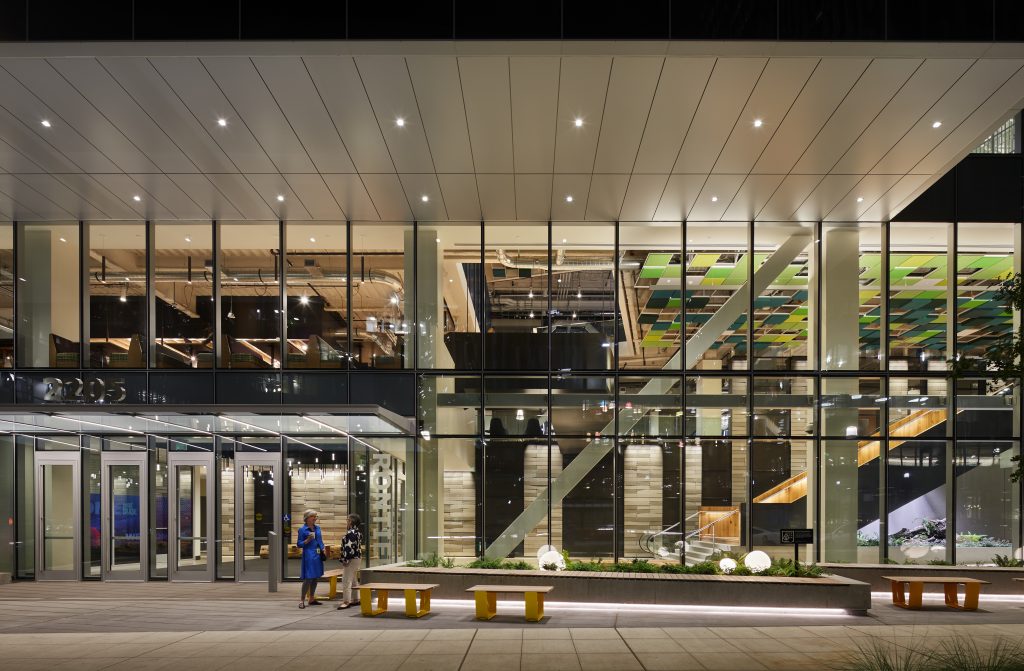Graphite Design Group develops an urban treehouse, full of social spaces, for Amazon‘s Seattle Office.
Project Overview:
- Design Firm: Graphite Design Group
- Client: Amazon
- Completion Date: 2022
- Location: Seattle, Washington, USA
- Size: 540,000 sq ft
Occupying a 2,600 Square Meter, half-block lot in Seattle’s central business district, the project brief was for a 40,000 SM office building, ground floor retail, and 1,200 SM childcare center.
The building’s structure is the armature, or “tree” through which the office program is woven and treehouse destinations discovered. Like lines on a map, steel and wood elements guide one’s journey through the building. Destinations are infused with character and identity, rich in color and texture, contrasting with the neutral surrounding context. A neutral exterior palette allows the interior spaces to read through to the neighborhood campus; where color is introduced, it relates to distinctly legible circulation and program gestures. These include a low-rise extension of the podium, which houses a daycare; the building core, expressed in a gradient of variegated blue tiles; and the companion wall to the central stair, which employs graduated green tones diminishing in intensity as the stair ascends.
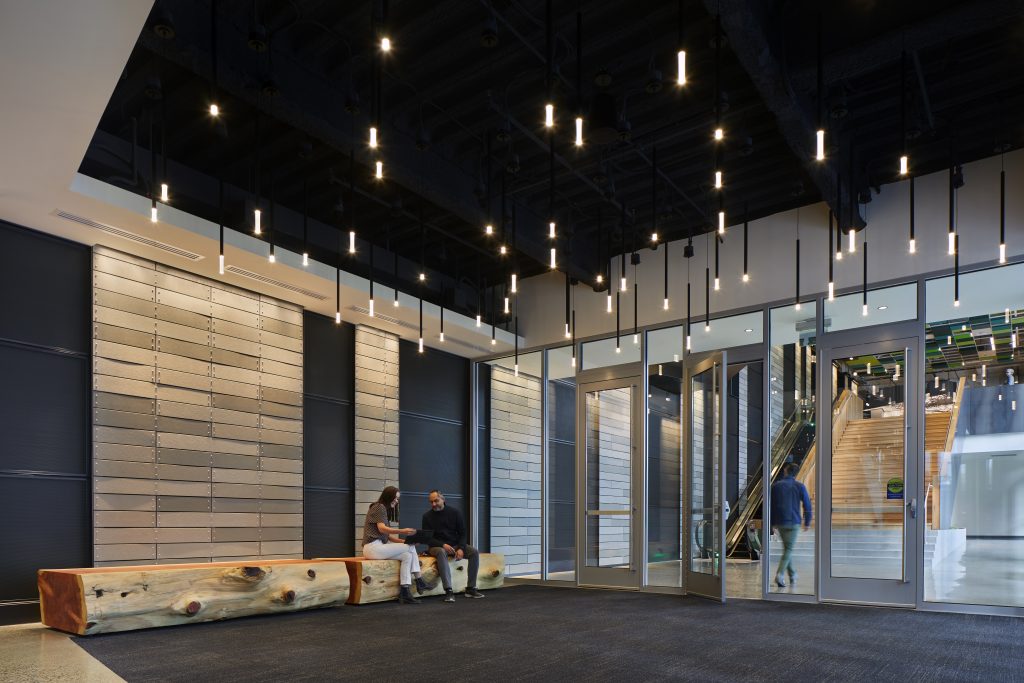
The stair is a social spine energizing every tower level, encouraging chance encounters, and expanding opportunities for interactions between individual occupants, teams, and guests. The office tower is also bracketed with collaborative social spaces at the building’s base and top, linked by the central stair that connects these and other additional shared program areas with focused workplace floors.
The tower’s structural solution is integral to the building form. Multi-story braced frames trace through the ascending tower, visible from the exterior as they follow the treehouse stair up the façade. These muscular braces are similarly revealed on the interior, where they express the armature of the “tree” through which the office program is woven. Distinctive ceilings and changes in floor material and level further define these interior experiences creating moments of prospect and refuge, compression and release, surprise, and delight. The result is a clear hierarchy of primary structure and secondary, place-making infill; memorably designed moments on one’s journey through the building.
The LEED V4 Gold certified project intertwines exterior and interior biophilic environments. Green roofs and landscaped terraces not only enhance the aesthetics but also play a crucial role in slowing down water runoff, mitigating the urban heat island effect. Interior landscaping is located adjacent to the open feature stair at various floor levels. Operable windows located on all office floors allow occupants to enliven their spaces with outside air, also benefiting the interior landscapes. The heating system utilizes high-efficiency heat recovery chillers designed to re-use otherwise wasted heat from neighboring data centers.
Sustainable thinking led to programmatic solutions as well to create a truly adaptable building. The offset core’s relationship to the feature stair successfully allows for changes to vertical and horizontal program distribution as occupant’s needs evolve. Individual floors may be subdivided, and the tower may be compartmentalized vertically to serve single or multiple tenants.
The urban treehouse offers an outpost from the forest of high-rise neighbors. Bridged together by a central staircase, the interior’s pathway for connectivity and togetherness represents the future of office buildings for the hybrid world. Frontier, while small in stature, is not lost in its context. It is in and of the forest of its high-rise neighbors, its own unique form in a neighborhood of taller siblings.
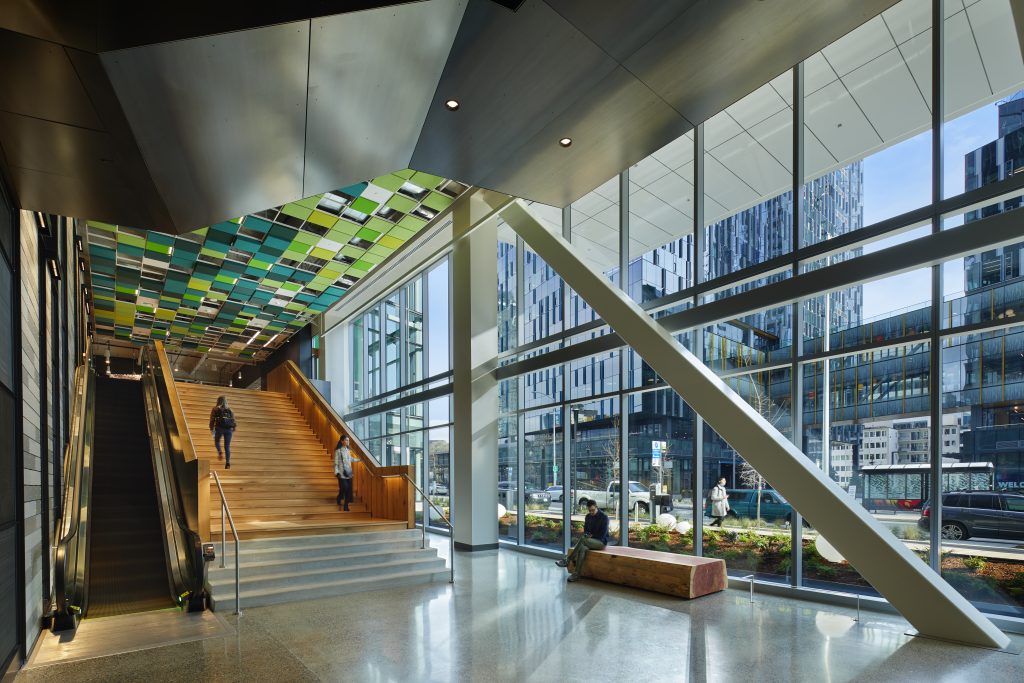
Project Planning
As the project is an expansion of an existing campus, and serves a global employee base, care was taken by the design team to coordinate client standards for workplace areas, amenities, and shared resources. The intent is for the project to have a distinct character, but with components and user interaction that will be familiar to all Amazon employees.
The project is the final tower in a 5-block master plan for Amazon. Acknowledging that this final phase is the smallest and shortest tower of the multi-building campus, the design team developed an architectural response that simultaneously extends the design vocabulary and urban networks initiated by the existing structures while creating a massing and experiential solution unique to the block.
Inspired by the concept of an “Urban Treehouse,” the building’s design seamlessly weaves nature and technology into its very core. The central open stair, reminiscent of the ascension to a treehouse, serves as a striking visual element, guiding occupants through the façade. Distinct floorplans revolve around this feature, creating moments of intrigue and discovery throughout the tower.
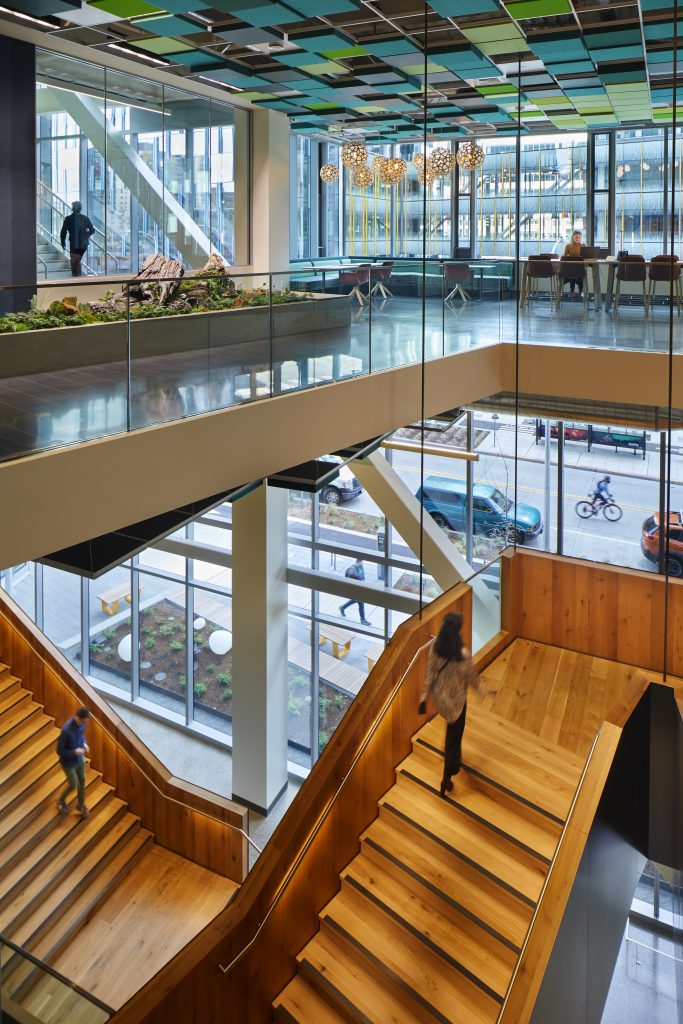
Project Details
Frontier presents itself as a unique reinterpretation of the high-rise office building typology. The building houses creative teams committed to curiosity, innovation, and exploration. Throughout the design, interior and exterior occupiable spaces appeal to the exploratory and experimental nature inherent in treehouses, structures that are unique reflections of the builders’ sensibilities.
The building’s structural solution is integral to Frontier’s design. The structure is the armature, or “tree” through which the office program is woven and treehouse destinations discovered. Like lines on a map, steel and wood elements guide one’s journey through the building. Destinations such as the Market, Reception, or Rooftop Games Lounge are infused with character and identity, rich in color and texture, contrasting with the neutral surrounding context. Distinctive ceilings and changes in floor material and level further define these interior experiences creating moments of prospect and refuge, compression and release, surprise, and delight. The result is a clear hierarchy of primary structure and secondary place-making infill; memorably designed moments on one’s journey through the building.
While not as tall as its towering neighbors, Block 18 is no less distinctive. The tower is clad in a flush curtain wall system, delineating the building form through changes in fenestration transparency and color. A largely neutral exterior palette allows the interior spaces to read through to the neighborhood campus. And where color is introduced, it relates to distinctly legible form and program gestures. These include a low-rise extension of the podium, which houses a daycare; the building core, expressed in a gradient of variegated blue tiles; and the companion wall to the central stair, which employs graduated green tones diminishing in intensity as it ascends.

Products
Exterior Wall Systems – All New Glass
Curtain Wall System – Bruce Wall Systems
Glass & Glazing – Viracon
Metal Panels – Morin
Concrete Wall Panels – Rieder
Louvers – Airolite
Elevators – Otis
Decorative Ceilings – Arktura
Fireplace – Acucraft
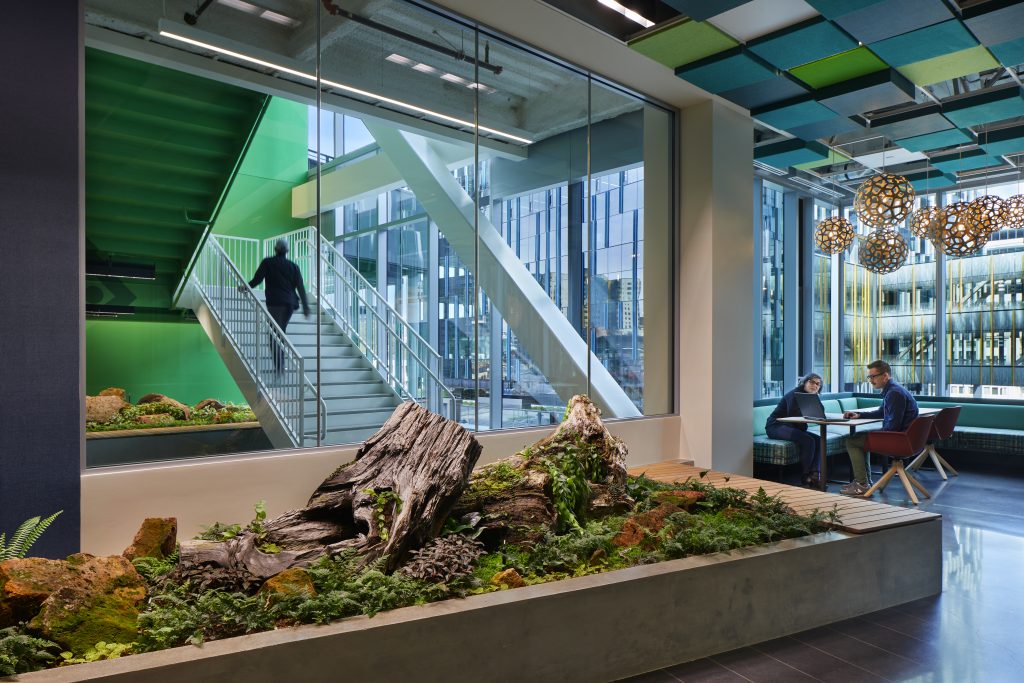
Overall Project Results
Feedback from management and employees has been universally positive. The unique character of the shared social spaces and easy, intuitive navigation of the building make it a favorite among Amazon employees in Seattle.
By maintaining Amazon’s workplace standards throughout, Frontier is in many ways immediately familiar to teams relocating or visiting from other campus buildings. However the diverse collection of unique spaces, vertical connections and urban views lend the building a unique character that is both distinct and memorable.
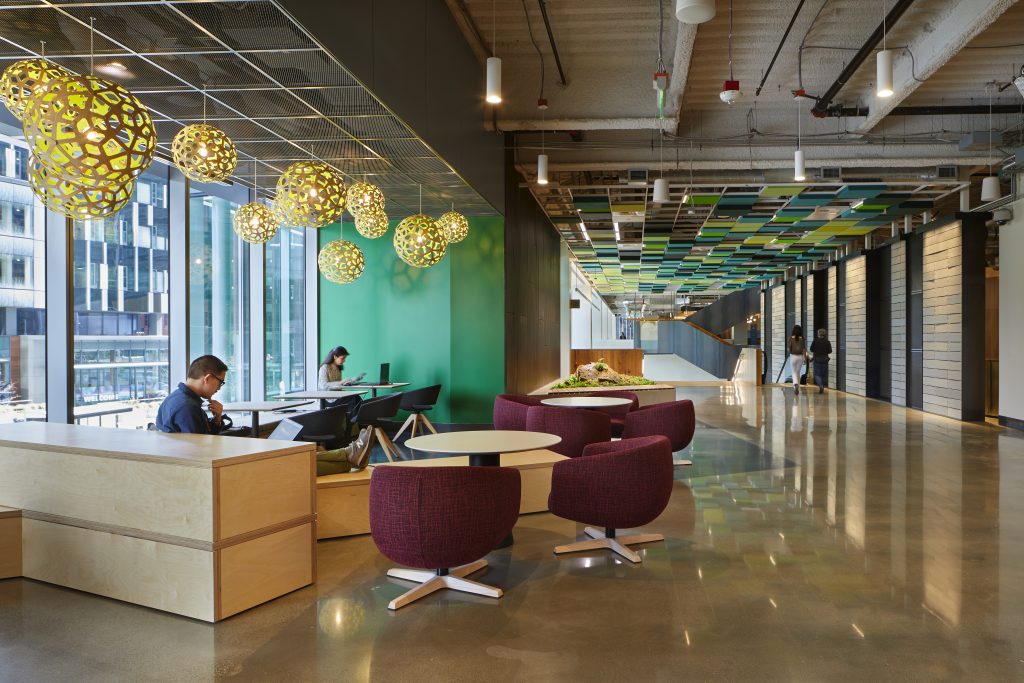
Contributors:
Owner: Amazon
Development Manager: The Seneca Group
General Contractor: Sellen Construction
Civil: Coughlin Porter Lundeen
Structural: Magnusson Klemencic Associates
Landscape: SiteWorkshop
Land Use: HCMP
Mechanical/Energy Design: WSP
Sustainability: Sellen Construction
Environmental Graphics: Studio SC
Fire Protection: McKinstry
Code Consultant: Jensen Hughes
Mechanical: PSF Mechanical
Plumbing: PSF Mechanical
Electrical Engineer: Stantec
Electrical Contractor: Cochran/Coffman
Lighting: Oculus Light Studio
Telecomm: Hargis
Vertical Transportation: Fortune Shepler Saling
Facade Access: Lerch Bates
Geotech: Geoengineers
Acoustics: Stantec
Food Service: ATK
Parking: Graelic
Security: ZBeta Consulting
Waterproofing: JRS Engineering
Curtain Wall: CDC
Wind Consulting: CPP
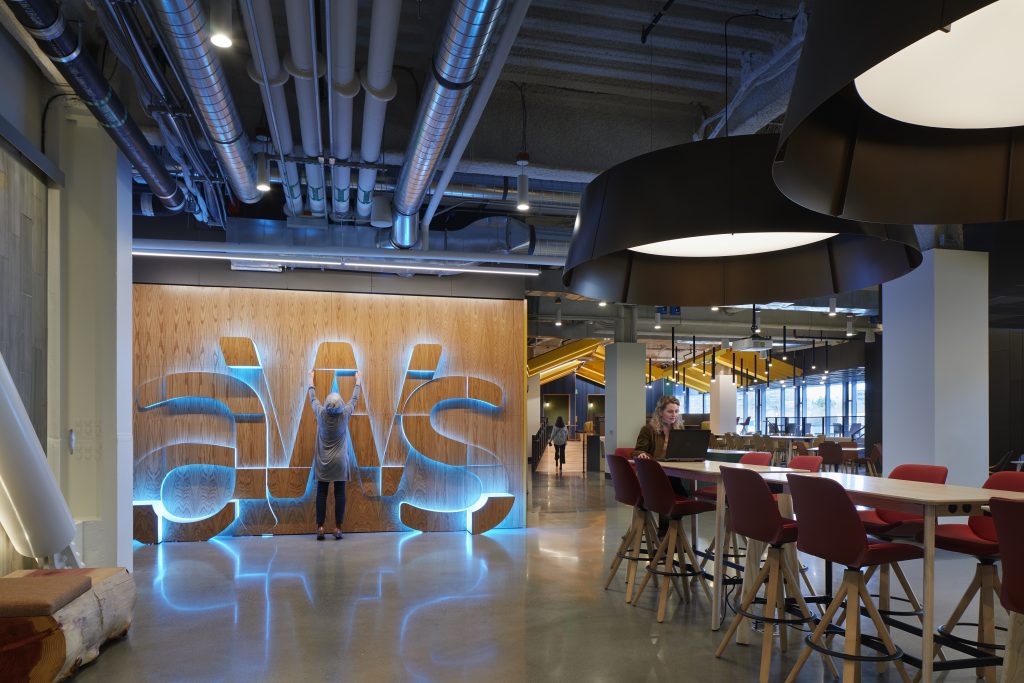
Design
Sonia Young
Photography
